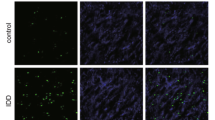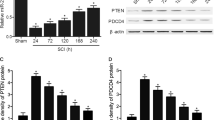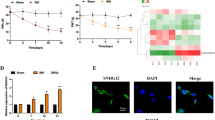Abstract
Cervical spondylosis may cause chronic neck pain, radiculopathy and/or myelopathy, and consequently results in severe brain damage. Glial cell line-derived neurotrophic factor (GDNF) is a potent neurotrophic factor for motoneurons. Accumulating microRNAs (miRNAs) have highlighted as critical regulators of GDNF signaling in the mediation of neuroinflammation and neuropathic pain. Hence, we performed this study to investigate the potential role of miR-204 in the neuropathic pain of cervical spondylotic radiculopathy (CSR) by targeting GDNF. A rat model of spinal cord compression (SCC) was established to stimulate a pathologic lesion. RT-qPCR and western blot assays characterized the downregulation of GDNF and the upregulation of miR-204 in spinal cord tissues of rats under the conditions of SCC. Moreover, miR-204 could directly target GDNF, as evidenced by dual-luciferase reporter gene assay. In order to elucidate the roles of miR-204 and GDNF in SCC-induced neuropathic pain, miR-204 sponge, GDNF, or shRNA against GDNF was introduced to the rats, followed by measurements for SCC-induced neuroinflammation and neuropathic pain. GDNF upregulation or miR-204 silencing was identified to reduce the spontaneous pain score, gait scores and cell apoptosis. Furthermore, GDNF upregulation or miR-204 silencing resulted in elevated amplitude of sensory-evoked potentials (SEPs), number of motoneurons, release of pro-inflammatory factors, TNF-α, and IL-1β in addition to an increase in the anti-inflammatory factor BDNF. Taken together, upregulation of GDNF induced by miR-204 silencing confers protection against SCC-induced pain in rat models, suggesting a potential therapeutic target for CSR treatment.
This is a preview of subscription content, access via your institution
Access options
Subscribe to this journal
Receive 12 print issues and online access
$259.00 per year
only $21.58 per issue
Buy this article
- Purchase on Springer Link
- Instant access to full article PDF
Prices may be subject to local taxes which are calculated during checkout






Similar content being viewed by others
References
Xiong W, Li F, Guan H. Tetraplegia after thyroidectomy in a patient with cervical spondylosis: a case report and literature review. Medicine (Baltimore). 2015;94:e524.
Yu CX, Li B, Xu YK, Ji TT, Li L, Zhao CJ, et al. Altered functional connectivity of the periaqueductal gray in chronic neck and shoulder pain. Neuroreport. 2017;28:720–5.
Sun W, Zheng K, Liu B, Fan D, Luo H, Qu X, et al. Neuroprotective potential of gentongping in rat model of cervical spondylotic radiculopathy targeting PPAR-gamma pathway. J Immunol Res. 2017;2017:9152960.
Yang F, Li WX, Liu Z, Liu L. Balance chiropractic therapy for cervical spondylotic radiculopathy: study protocol for a randomized controlled trial. Trials. 2016;17:513.
Sheng SR, Wang K, Nisar M, Chen JX, Wu AM, Wang XY. A novel technique for cervical facet joint hyperplasia-spondylotic radiculopathy by laminar and lateral mass screw cofixations. World Neurosurg. 2018;110:e490–5.
Saldana MT, Navarro A, Perez C, Masramon X, Rejas J. Patient-reported-outcomes in subjects with painful lumbar or cervical radiculopathy treated with pregabalin: evidence from medical practice in primary care settings. Rheumatol Int. 2010;30:1005–15.
Saugstad JA. MicroRNAs as effectors of brain function with roles in ischemia and injury, neuroprotection, and neurodegeneration. J Cereb Blood Flow Metab. 2010;30:1564–76.
Liu NK, Xu XM. MicroRNA in central nervous system trauma and degenerative disorders. Physiol Genomics. 2011;43:571–80.
Shi G, Shi J, Liu K, Liu N, Wang Y, Fu Z, et al. Increased miR-195 aggravates neuropathic pain by inhibiting autophagy following peripheral nerve injury. Glia. 2013;61:504–12.
Gao R, Wang L, Sun J, Nie K, Jian H, Gao L, et al. MiR-204 promotes apoptosis in oxidative stress-induced rat Schwann cells by suppressing neuritin expression. FEBS Lett. 2014;588:3225–32.
Maheu M, Lopez JP, Crapper L, Davoli MA, Turecki G, Mechawar N. MicroRNA regulation of central glial cell line-derived neurotrophic factor (GDNF) signalling in depression. Transl Psychiatry. 2015;5:e511.
Flachsbarth K, Jankowiak W, Kruszewski K, Helbing S, Bartsch S, Bartsch U. Pronounced synergistic neuroprotective effect of GDNF and CNTF on axotomized retinal ganglion cells in the adult mouse. Exp Eye Res. 2018;176:258–65.
Chu TH, Wang L, Guo A, Chan VW, Wong CW, Wu W. GDNF-treated acellular nerve graft promotes motoneuron axon regeneration after implantation into cervical root avulsed spinal cord. Neuropathol Appl Neurobiol. 2012;38:681–95.
Brambilla L, Martorana F, Guidotti G, Rossi D. Dysregulation of astrocytic HMGB1 signaling in amyotrophic lateral sclerosis. Front Neurosci. 2018;12:622.
Chen M, Ba H, Lu C, Dai J, Sun J. Glial cell line-derived neurotrophic factor (GDNF) promotes angiogenesis through the demethylation of the fibromodulin (FMOD) promoter in glioblastoma. Med Sci Monit. 2018;24:6137–43.
Lo YL, Cheong PW, George JM, Tan SB, Yue WM, Guo CM, et al. Pregabalin and radicular pain study (PARPS) for cervical spondylosis in a multiracial asian population. J Clin Med Res. 2014;6:66–71.
Onda A, Kimura M. Comparisons between the efficacy of limaprost alfadex and pregabalin in cervical spondylotic radiculopathy: design of a randomized controlled trial. Fukushima J Med Sci. 2018;64:73–81.
Kusuda R, Cadetti F, Ravanelli MI, Sousa TA, Zanon S, De Lucca FL, et al. Differential expression of microRNAs in mouse pain models. Mol Pain. 2011;7:17.
Andersen HH, Duroux M, Gazerani P. MicroRNAs as modulators and biomarkers of inflammatory and neuropathic pain conditions. Neurobiol Dis. 2014;71:159–68.
Zhang X, Di G, Dong M, Qu M, Zhao X, Duan H, et al. Epithelium-derived miR-204 inhibits corneal neovascularization. Exp Eye Res. 2018;167:122–7.
Wang J, Duncan D, Shi Z, Zhang B. WEB-based GEne SeT analysis toolkit (WebGestalt): update 2013. Nucleic Acids Res. 2013;41:W77–83.
Duarte EP, Curcio M, Canzoniero LM, Duarte CB. Neuroprotection by GDNF in the ischemic brain. Growth Factors. 2012;30:242–57.
Brambilla L, Guidotti G, Martorana F, Iyer AM, Aronica E, Valori CF, et al. Disruption of the astrocytic TNFR1-GDNF axis accelerates motor neuron degeneration and disease progression in amyotrophic lateral sclerosis. Hum Mol Genet. 2016;25:3080–95.
Gruber HE, Jones B, Marrero E, Hanley EN Jr. Proinflammatory cytokines IL-1beta and TNF-alpha influence human annulus cell signaling cues for neurite growth: in vitro coculture studies. Spine (Phila Pa 1976). 2017;42:1529–37.
Shen LH, Li Y, Chopp M. Astrocytic endogenous glial cell derived neurotrophic factor production is enhanced by bone marrow stromal cell transplantation in the ischemic boundary zone after stroke in adult rats. Glia. 2010;58:1074–81.
Kitiyanant N, Kitiyanant Y, Svendsen CN, Thangnipon W. BDNF-, IGF-1- and GDNF-secreting human neural progenitor cells rescue amyloid beta-induced toxicity in cultured rat septal neurons. Neurochem Res. 2012;37:143–52.
Chen A, Lin Z, Lan L, Xie G, Huang J, Lin J, et al. Electroacupuncture at the Quchi and Zusanli acupoints exerts neuroprotective role in cerebral ischemia-reperfusion injured rats via activation of the PI3K/Akt pathway. Int J Mol Med. 2012;30:791–6.
Yuan M, Wen SJ, Yang CX, Pang YG, Gao XQ, Liu XQ, et al. Transplantation of neural stem cells overexpressing glial cell line-derived neurotrophic factor enhances Akt and Erk1/2 signaling and neurogenesis in rats after stroke. Chin Med J (Engl). 2013;126:1302–9.
Iannelli A, de Sousa G, Zucchini N, Saint-Paul MC, Gugenheim J, Rahmani R. Anti-apoptotic pro-survival effect of clotrimazole in a normothermic ischemia reperfusion injury animal model. J Surg Res. 2011;171:101–7.
Li G, Luna C, Qiu J, Epstein DL, Gonzalez P. Role of miR-204 in the regulation of apoptosis, endoplasmic reticulum stress response, and inflammation in human trabecular meshwork cells. Invest Ophthalmol Vis Sci. 2011;52:2999–3007.
Yue P, Gao L, Wang X, Ding X, Teng J. Intranasal administration of GDNF protects against neural apoptosis in a rat model of Parkinson’s disease through PI3K/Akt/GSK3beta pathway. Neurochem Res. 2017;42:1366–74.
Xing B, Xin T, Zhao L, Hunter RL, Chen Y, Bing G. Glial cell line-derived neurotrophic factor protects midbrain dopaminergic neurons against lipopolysaccharide neurotoxicity. J Neuroimmunol. 2010;225:43–51.
Kawakami M, Weinstein JN, Spratt KF, Chatani K, Traub RJ, Meller ST, et al. Experimental lumbar radiculopathy. Immunohistochemical and quantitative demonstrations of pain induced by lumbar nerve root irritation of the rat. Spine (Phila Pa 1976). 1994;19:1780–94.
Dubuisson D, Dennis SG. The formalin test: a quantitative study of the analgesic effects of morphine, meperidine, and brain stem stimulation in rats and cats. Pain. 1977;4:161–74.
Acknowledgements
We acknowledge and appreciate our colleagues for their valuable efforts and comments on this paper.
Author information
Authors and Affiliations
Corresponding author
Ethics declarations
Conflict of interest
The authors declare that they have no conflict of interest.
Additional information
Publisher’s note Springer Nature remains neutral with regard to jurisdictional claims in published maps and institutional affiliations.
Rights and permissions
About this article
Cite this article
Shen, WS., Li, CF., Zhou, ZS. et al. MicroRNA-204 silencing relieves pain of cervical spondylotic radiculopathy by targeting GDNF. Gene Ther 27, 254–265 (2020). https://doi.org/10.1038/s41434-019-0114-3
Received:
Revised:
Accepted:
Published:
Issue Date:
DOI: https://doi.org/10.1038/s41434-019-0114-3
This article is cited by
-
Prenatal BPA exposure disrupts male reproductive functions by interfering with DNA methylation and GDNF expression in the testes of male offspring rats
Environmental Science and Pollution Research (2023)



